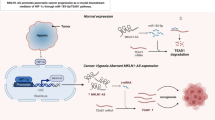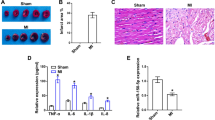Abstract
Myocardial infarction (MI) is severe heart disease leading to the death worldwide. Long noncoding RNAs (lncRNAs) play a vital role in progression of numerous heart diseases. In the present study, we examined the effects of lncRNA XIST and underlying mechanism on hypoxia-induced apoptosis. In vitro model of MI was established by inducing hypoxia in H9c2 cells. CCK-8 assay was used to measure the cell viability in hypoxia-induced H9c2 cells. The rate of cell apoptosis was assessed by using caspase-3 assay. Transfection was carried out to upregulate the expressions of lncRNA XIST, and miR-486-5p. RT-qPCR was used to measure the levels of lncRNA XIST and miR-486-5p. Also, the relation between XIST and miR-486-5p was confirmed by using Luciferase reporter assay. Our findings revealed that hypoxia significantly downregulated the expressions of XIST. Also, the cell viability markedly increased due to the overexpression of XIST in hypoxia-induced H9c2 cells, while overexpression of XIST significantly reduced the cell apoptosis in hypoxia-induced H9c2 cells. On the other hand, opposite effects were observed due to the downregulation of XIST in hypoxia-induced H9c2 cells. Moreover, XIST negatively regulated the expression of miR-4486-5p and upregulation of XIST inhibited hypoxic injury by downregulating miR-486-5p. Furthermore, SIRT1 expression was negatively regulated by miR-486-5p. We concluded that lncRNA XIST might provide protection against injury induced by hypoxia via miR-486-5p/SIRT1 axis.




Similar content being viewed by others

References
Benjamin, E. J., et al. (2018). Heart Disease and Stroke Statistics-2018 Update: A Report From the American Heart Association. Circulation, 137(12), e67–e492.
Lu, L., et al. (2015). Myocardial Infarction: Symptoms and Treatments. Cell Biochemistry and Biophysics, 72(3), 865–867.
Moe, G. W., & Marin-Garcia, J. (2016). Role of cell death in the progression of heart failure. Heart Failure Reviews, 21(2), 157–167.
Cabili, M. N., et al. (2011). Integrative annotation of human large intergenic noncoding RNAs reveals global properties and specific subclasses. Genes & Development, 25(18), 1915–1927.
Kung, J. T., Colognori, D., & Lee, J. T. (2013). Long noncoding RNAs: Past, present, and future. Genetics, 193(3), 651–669.
Chureau, C., et al. (2011). Ftx is a non-coding RNA which affects Xist expression and chromatin structure within the X-inactivation center region. Human Molecular Genetics, 20(4), 705–718.
Gendrel, A. V., & Heard, E. (2011). Fifty years of X-inactivation research. Development, 138(23), 5049–5055.
Minajigi, A., et al. (2015). Chromosomes. A comprehensive Xist interactome reveals cohesin repulsion and an RNA-directed chromosome conformation. Science, 349(6245), aab2276-1-12.
Xiong, Y., et al. (2017). The Long Non-Coding RNA XIST Interacted with MiR-124 to Modulate Bladder Cancer Growth, Invasion and Migration by Targeting Androgen Receptor (AR). Cellular Physiology and Biochemistry, 43(1), 405–418.
Song, H., et al. (2017). Long non-coding RNA XIST functions as an oncogene in human colorectal cancer by targeting miR-132-3p. Journal of B.U.ON., 22(3), 696–703.
Wang, H., et al. (2017). The Long Non-Coding RNA XIST Controls Non-Small Cell Lung Cancer Proliferation and Invasion by Modulating miR-186-5p. Cellular Physiology and Biochemistry, 41(6), 2221–2229.
Wei, W., et al. (2017). LncRNA XIST Promotes Pancreatic Cancer Proliferation Through miR-133a/EGFR. Journal of Cellular Biochemistry, 118(10), 3349–3358.
Gu, S., et al. (2017). Long Coding RNA XIST Contributes to Neuronal Apoptosis through the Downregulation of AKT Phosphorylation and Is Negatively Regulated by miR-494 in Rat Spinal Cord Injury. International Journal of Molecular Sciences, 18(4), 1–17.
Narasimhan, M., & Rajasekaran, N. S. (2016). Exercise, Nrf2 and Antioxidant Signaling in Cardiac Aging. Frontiers in Physiology, 7, 241.
Konet, D. S., Anderson, J., Piper, J., Akkina, R., Suchman, E., & Carlson, J. (2007). Short-hairpin RNA expressed from polymerase III promoters mediates RNA interference in mosquito cells. Insect Molecular Biology, 16(2), 199–206.
Buja, L. M. (2005). Myocardial ischemia and reperfusion injury. Cardiovascular Pathology, 14(4), 170–175.
Tanaka, M., et al. (1994). Hypoxia induces apoptosis with enhanced expression of Fas antigen messenger RNA in cultured neonatal rat cardiomyocytes. Circulation Research, 75(3), 426–433.
Lekka, E., & Hall, J. (2018). Noncoding RNAs in disease. FEBS Letters, 592(17), 2884–2900.
Chen, D. L., et al. (2017). Long noncoding RNA XIST expedites metastasis and modulates epithelial-mesenchymal transition in colorectal cancer. Cell Death & Disease, 8(8), e3011.
Zhou, T., et al. (2019). LncRNA XIST regulates myocardial infarction by targeting miR-130a-3p. Journal of Cellular Physiology, 234(6), 8659–8667.
Xiao, C., et al. (2018). Transplanted Mesenchymal Stem Cells Reduce Autophagic Flux in Infarcted Hearts via the Exosomal Transfer of miR-125b. Circulation Research, 123(5), 564–578.
Vinas, J. L., et al. (2016). Transfer of microRNA-486-5p from human endothelial colony forming cell-derived exosomes reduces ischemic kidney injury. Kidney International, 90(6), 1238–1250.
Ruan, H., et al. (2009). Inducible and cardiac specific PTEN inactivation protects ischemia/reperfusion injury. Journal of Molecular and Cellular Cardiology, 46(2), 193–200.
Pediconi, N., et al. (2009). hSirT1-dependent regulation of the PCAF-E2F1-p73 apoptotic pathway in response to DNA damage. Molecular and Cellular Biology, 29(8), 1989–1998.
Rathbone, C. R., Booth, F. W., & Lees, S. J. (2009). Sirt1 increases skeletal muscle precursor cell proliferation. European Journal of Cell Biology, 88(1), 35–44.
Zu, Y., et al. (2010). SIRT1 promotes proliferation and prevents senescence through targeting LKB1 in primary porcine aortic endothelial cells. Circulation Research, 106(8), 1384–1393.
Kim, H. K., et al. (2008). Alterations in the proangiogenic functions of adipose tissue-derived stromal cells isolated from diabetic rats. Stem Cells Dev, 17(4), 669–680.
Funding
This study was funded by Nanjing Medical University Kangda College Research Development Fund Project KD2018KYJJYB045.
Author information
Authors and Affiliations
Contributions
All the authors contributed equally in drafting the manuscript.
Corresponding author
Ethics declarations
Not Applicable.
Ethical approval.
Not Applicable.
Consent to Participate (Ethics)
Not Applicable.
Consent to Publish (Ethics)
All the authors have consent to publish.
Informed consent
All the authors have the consent.
Conflict of Interest
The authors do not have any conflict of interest.
Additional information
Publisher's Note
Springer Nature remains neutral with regard to jurisdictional claims in published maps and institutional affiliations.
Rights and permissions
Springer Nature or its licensor holds exclusive rights to this article under a publishing agreement with the author(s) or other rightsholder(s); author self-archiving of the accepted manuscript version of this article is solely governed by the terms of such publishing agreement and applicable law.
About this article
Cite this article
Xie, J. Long Noncoding RNA XIST Regulates Myocardial Infarction via miR-486-5p/SIRT1 Axis. Appl Biochem Biotechnol 195, 725–734 (2023). https://doi.org/10.1007/s12010-022-04165-3
Accepted:
Published:
Issue Date:
DOI: https://doi.org/10.1007/s12010-022-04165-3



